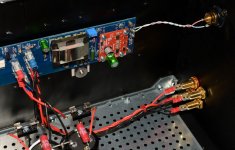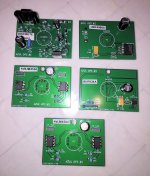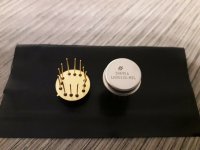I will be testing that in more depth.F6 and M2x have a lot of overlap sonically.
F6 and M2x have a lot of overlap sonically. If you're gutting the F5, build an Aleph J or wait for the next amp to papa to release...
I find the Jensen in the F6 more pleasing than the Edcor in the M2x. Yes, different topology. Also, I think the F6 with manual bias can be set right on that razor's edge between just enough to smooth things out and too much heat.
Great examples of how we each have different perceptions of amps.
I found F6 to be similar to F5 than M2. All of them are excellent, so no flame here. I found F5 toTEND towards the thinner side of the scale from mid highs up, and F6 similar due to very clean sounding high end of the scale.
I kind of preferred it to F5, I think. My F5 is an earlier version without P3, which would likely help it as far as my preferences are concerned.
With M2, I found it more forgiving although still having great transparency. A solid performer with spacious sound. I need to build my set of marks boards, my M2 is teabags, so have only listened to original version. I need more cases, have a few builds needing them. I have all the parts and edcors waiting for Marks version.
With AlephJ, well, I just enjoy that amp and am always happy when it goes in system.
F6 has a great upper frequency, which could be really nice with proper speaker tuned to it. I find M2 to like everything I've thrown at it.
All of this is going to vary based on front end, rooms and speakers, not to mention everyone's different ears!
Hard to go wrong with Pass diy. Transformed my previous listening for sure.
Russellc
I found F6 to be similar to F5 than M2. All of them are excellent, so no flame here. I found F5 toTEND towards the thinner side of the scale from mid highs up, and F6 similar due to very clean sounding high end of the scale.
I kind of preferred it to F5, I think. My F5 is an earlier version without P3, which would likely help it as far as my preferences are concerned.
With M2, I found it more forgiving although still having great transparency. A solid performer with spacious sound. I need to build my set of marks boards, my M2 is teabags, so have only listened to original version. I need more cases, have a few builds needing them. I have all the parts and edcors waiting for Marks version.
With AlephJ, well, I just enjoy that amp and am always happy when it goes in system.
F6 has a great upper frequency, which could be really nice with proper speaker tuned to it. I find M2 to like everything I've thrown at it.
All of this is going to vary based on front end, rooms and speakers, not to mention everyone's different ears!
Hard to go wrong with Pass diy. Transformed my previous listening for sure.
Russellc
Last edited:
My two most-favorites are
1. Tucson with LT1122 opamp (thru hole)
2. Norwood with AD744 and HA-5002 (SMD)
LT1122s arrived from Mouser this afternoon. I removed the Ishikawa boards (with Toshiba JFETs) and installed the Tucson boards with LT1122s. Listening right now and not missing the Toshibas! A great alternative for those who don’t want to pay the ever-increasing price for the Toshiba JFETs.
Thanks Mark, for the recommendation.
LT1122 ... A great alternative for those who don’t want to pay the ever-increasing price for the Toshiba JFETs.
I'm very happy you like them!
They are JFET opamps, maybe that's what makes them sound so good.
Today I decided to take out the Tucson input boards with OPA604 and try out the Norwoods (MJ-version). It was after reading the data sheet for the Harris HA5002 buffer:
http://www.farnell.com/datasheets/30804.pdf
Impressing specs like 1300V/us slewrate, 200mA drive capability and 110 MHz bandwidth. Seems just right to drive the Edcor…...and bandwidth good enough for audio?
I wonder if a normal opamp has a hard time driving the Edcor?
What I can say so far is that Norwoods are very good sounding. Think there is a clear improvement from Tucson. Sound stage wider and deeper and deep bas more detailed (if deep bas can be detailed). Think it handles complex music better than Tucson (more "air" and "space").
It is easy to get too excited when you have just installed something new and it seems to work…….so description very subjective…….but so far so good
Will see how it performs in the "long run".
http://www.farnell.com/datasheets/30804.pdf
Impressing specs like 1300V/us slewrate, 200mA drive capability and 110 MHz bandwidth. Seems just right to drive the Edcor…...and bandwidth good enough for audio?
I wonder if a normal opamp has a hard time driving the Edcor?
What I can say so far is that Norwoods are very good sounding. Think there is a clear improvement from Tucson. Sound stage wider and deeper and deep bas more detailed (if deep bas can be detailed). Think it handles complex music better than Tucson (more "air" and "space").
It is easy to get too excited when you have just installed something new and it seems to work…….so description very subjective…….but so far so good
Will see how it performs in the "long run".
Attachments
@MEPER, does your mu-metal go underneath the Edcor or just wrap over the top? Have you always had the shield or did you have to add it due to noise?
I have built M2 with Teabag's board but was ordering other things from the store so added M2X boards to my order.
On high sensitivity speakers (FH with Fostex FE126) I can hear 60 or 120Hz noise (don't remember - too many amps, using Sissysit and Papa original J2 now).
When I build the M2X I will wrap it but don't know if it is ok to wrap the Edcor all the way around before installing it or if the loop becomes a problem itself.
I have built M2 with Teabag's board but was ordering other things from the store so added M2X boards to my order.
On high sensitivity speakers (FH with Fostex FE126) I can hear 60 or 120Hz noise (don't remember - too many amps, using Sissysit and Papa original J2 now).
When I build the M2X I will wrap it but don't know if it is ok to wrap the Edcor all the way around before installing it or if the loop becomes a problem itself.
It goes all the way round the Edcor. I think that is an advantage over just a box that covers the top. First I wrapped 3M tinned copper tape around it and op top of that the mu-metal. I did it to begin with as many reported hum pickup. I have 94 dB speakers and they are silent with ear close to the speaker units. The distortion measurements also showed that 50/100 Hz was very well dampened. I am very "hum sensitive" so I will do what it takes to remove it  .....the PSU is a CRCLC to get ripple down into about 1 mV or so and toroid is in the far corner of the 5U Deluxe (mono blocks) and has a band of magnetic shield around it (special double layer steel).
.....the PSU is a CRCLC to get ripple down into about 1 mV or so and toroid is in the far corner of the 5U Deluxe (mono blocks) and has a band of magnetic shield around it (special double layer steel).
Good old 6L6 reminds me that the output stage of the "Azul" headphone amp presented at Burning Amp 2019, would make a very fine daughter card IPS for the M2x amplifier. It would use the multi chip module called LH0033, first sold in 1971 (!), to implement an M2x input stage buffer, on the same daughter card form factor as all the other M2x IPS cards.
Besides offering wonderful sonics (according to the folks who listened to Azul at Burning Amp), the LH0033 offers many of the characteristics that rabid audiophiles require:
You could build it as a standalone buffer, somewhat resembling Tucson. Or you could build it as the back end of a composite amplifier, strongly resembling Norwood. Or both!
I successfully implemented a 12 pin TO-99 "socket" for the LH0033 on Azul, using 0.1" breakaway pin SIPs, Mouser.com P/N 437-3108716441001101. Putting these on M2x daughter cards would let you move a single pair of (expensive!) LH0033s from one set of cards to another. You could try several different circuit designs and pick the one whose sound pleases you most.
I also exhibited a few "LH0033 emulators" at BAF. These are pin-compatible with the LH0033, but built with active production, cheap semiconductors. These let me debug the Azul motherboard without worrying that I might damage an expensive and hard-to-replace LH0033. As M2x owners will readily observe, they ALSO gave me a headphone amp with interchangeable output stages. Just like M2x but on the output not the input. More listening experiments. Oh boy!
_
Besides offering wonderful sonics (according to the folks who listened to Azul at Burning Amp), the LH0033 offers many of the characteristics that rabid audiophiles require:
- It is out of production
- Vendors of New Old Stock offer it for nosebleed prices; check octopart.com . A month before Burning Amp 2019, I purchased another two LH0033s as emergency spares, and paid $25 per piece. Plus shipping.
- It is housed in a 12-pin TO-99 circular metal can package. Audiophiles are convinced that circuits in round metal can packages sound better than in epoxy DIPs.
- It is built in an old & exotic technology (a dozen discretes in bare die, wirebonded to a ceramic substrate), in this case called "Linear Hybrid". That's why the part number begins with LH
- Its datasheet (attached) says that it is part of the family of Damn Fast buffers. Who dares to argue with that?
- Its bandwidth and slew rate are enormous; ridiculously excessive for audio
I successfully implemented a 12 pin TO-99 "socket" for the LH0033 on Azul, using 0.1" breakaway pin SIPs, Mouser.com P/N 437-3108716441001101. Putting these on M2x daughter cards would let you move a single pair of (expensive!) LH0033s from one set of cards to another. You could try several different circuit designs and pick the one whose sound pleases you most.
I also exhibited a few "LH0033 emulators" at BAF. These are pin-compatible with the LH0033, but built with active production, cheap semiconductors. These let me debug the Azul motherboard without worrying that I might damage an expensive and hard-to-replace LH0033. As M2x owners will readily observe, they ALSO gave me a headphone amp with interchangeable output stages. Just like M2x but on the output not the input. More listening experiments. Oh boy!
_
Attachments
I took the chance and got some LH0033 on ebay. I avoided sellers from China and Hongkong as the devices they sell did not look as NOS.
I got 10 of the G-version which should be ok at a reasonable price. Then I have something to play with...…..when I have finished all the other "projects" in the pibeline
But what about the LH0063? …...6 kV/us or 6V/ns risetime.....I like that….now 1500V/us is quite low......and just at the limit for audio?
I got 10 of the G-version which should be ok at a reasonable price. Then I have something to play with...…..when I have finished all the other "projects" in the pibeline
But what about the LH0063? …...6 kV/us or 6V/ns risetime.....I like that….now 1500V/us is quite low......and just at the limit for audio?
Attachments
Great, have fun with those! If you want to horse around with the LH0063 as well, I certainly have no objection. That hybrid is built inside a big TO-3 package, whose lead wires probably need much larger diameter holes in the PCB and/or socket.
I started fooling around with the LH0033, simply because I have had six or eight of them in my parts drawers for at least 25 years. I finally decided: c'mon, let's Build Something!
I started fooling around with the LH0033, simply because I have had six or eight of them in my parts drawers for at least 25 years. I finally decided: c'mon, let's Build Something!
Is it possible to “roll” the edcors? I’m curious about the sound of different transformer core materials. Nickel, etc.
To really do it right, you'd want to create new PCBs that include footprints for the Edcor transformers, AND the Cinemag transformers, AND the Jensen transformers. Presumably that's exactly what they did on the prototypes at First Watt, before performing the listening tests that settled upon the Edcors as the ones to ship.
You'd want to make the connection pads and holes for all transformers, to have extra large holes. That way you have a better chance of sucking out all the solder when you want to unsolder a Jensen and replace it with an Edcor etc. Either using your Edsyn Soldapullt (manual) or your Hakko FR-300 (automatic).
I don't know who will lay out these boards for you, except I'm sure it won't be me.
_
You will have to search the websites of the other transformer vendors and read their application notes, to learn whether they recommend an RC loading network across the transformer output.
OR
You could decide that you're going to learn the answers, experimentally. Test each transformer in your lab, with a variety of different RC loading networks, and see which network gives the best performance in your opinion. Another diyAudio member began a set of experiments to explore different RC loading networks for the Edcor transformer, right in this thread. If I remember correctly, he found that Jensen Transformers' documentation appears to state that Jensen seeks the best possible match to a Bessel transient response. But you are not required to do it their way. You can, and perhaps you should, do it YOUR way. Maybe you wish to optimize the frequency response rather than the transient response. Totally your decision.
OR
You could decide that you're going to learn the answers, experimentally. Test each transformer in your lab, with a variety of different RC loading networks, and see which network gives the best performance in your opinion. Another diyAudio member began a set of experiments to explore different RC loading networks for the Edcor transformer, right in this thread. If I remember correctly, he found that Jensen Transformers' documentation appears to state that Jensen seeks the best possible match to a Bessel transient response. But you are not required to do it their way. You can, and perhaps you should, do it YOUR way. Maybe you wish to optimize the frequency response rather than the transient response. Totally your decision.
As far as I remember in ZM's M25amp he uses Cinemag and has designed a compensation network for it. So people who want to use Cinemag could read the M25 thread. Also I remember something about "trimming" the Cinemag pins to maybe fit as an Edcor…..but not sure about that….but it will not "hurt" to read the M25 thread anyway. It seems Nelson perfer the Edcor and ZM the Cinemag.
If I were inclined to roll the signal transformers in my M2x, I would create a mezzanine adapter board to map the pinout of Jensen, Cinemag, Lundahl, etc. into the pinout of the Edcor. The adapter board can be a relatively simple single-sided, hand etched PCB. Swapping transformers also allows further exploration with different gain setting of input stage vs transformer. One could, for example, use the transformer as a simple 2x gain stage, and design an input stage with 12 dB of gain to go in front of it.
- Home
- Amplifiers
- Pass Labs
- The diyAudio First Watt M2x


